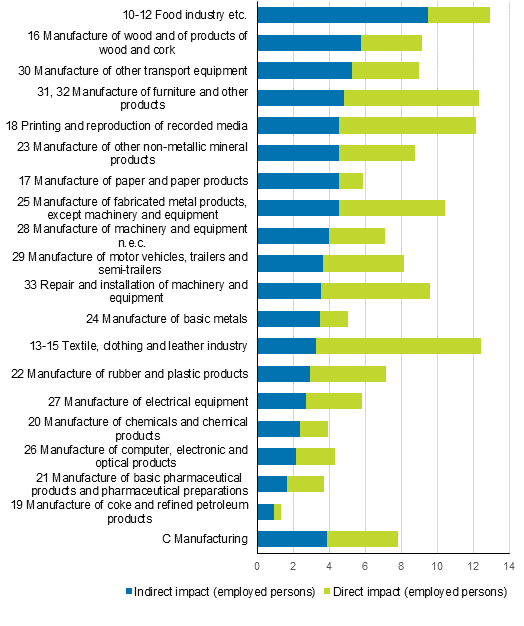Published: 27 November 2020
Food industry had the highest indirect employment impacts of manufacturing in 2017
According to Statistics Finland's input-output statistics, the food industry had the highest indirect impacts of all manufacturing industries on employment in Finland's national economy in 2017. The indirect impact of an increase of EUR one million in the final use (consumption expenditure + gross capital formation + exports) of the products of the industry on the number of employed persons in the whole economy was 9.5 employed persons. The indirect employment impacts were next highest in the manufacture of wood and of products of wood and cork (5.7) and in the manufacture of other transport equipment (5.2).
Indirect and direct labour input factors in manufacturing in 2017

The data are based on the “Labour input and labour input coefficients” table of the input-output statistics. The total impact on the number of employed persons is comprised of direct and indirect impacts. Direct impact is the direct impact of an increase of EUR one million in the final use demand (consumption expenditure + gross capital formation + exports) of the product on the industry's employment. In indirect impacts, account is taken of the multiplier impacts of an increase of EUR one million in the final use demand through intermediate consumption inputs bought from other industries on the production and employment of other industries.
The indirect impacts on employment are higher the higher the share of the industry's intermediate consumption inputs is domestic output and the more labour-intensive these industries that produce intermediate consumption inputs are. In the food industry, for example, 78 per cent of intermediate consumption inputs were domestic output and one-third of that output from labour-intensive crop and animal production, hunting and related service activities. Correspondingly, 78 per cent of intermediate consumption inputs in the manufacture of coke and refined petroleum products were imported products and the indirect labour input coefficient was 0.9, which was the lowest among manufacturing industries.
Statistics Finland publishes annually the supply and use tables describing product flows in the national economy, and the input-output and analysis tables derived from them. The data published now concern the year 2017. Tables concerning 2018 will be published in April 2021.
Source: Input-output 2017, Statistics Finland.
Inquiries: Markku Räty 029 551 2647, Ville Lindroos 029 551 3323, kansantalous@stat.fi
Head of Department in charge: Mari Ylä-Jarkko
Publication in pdf-format (172.7 kB)
- Tables
-
Tables in databases
Pick the data you need into tables, view the data as graphs, or download the data for your use.
Updated 27.11.2020
Official Statistics of Finland (OSF):
Input-output [e-publication].
ISSN=1799-201X. 2017. Helsinki: Statistics Finland [referred: 14.12.2025].
Access method: http://stat.fi/til/pt/2017/pt_2017_2020-11-27_tie_001_en.html

